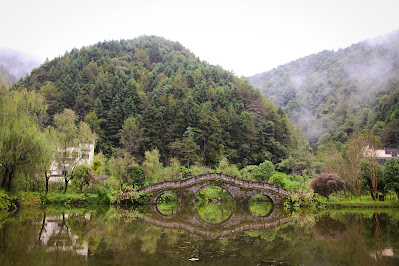On our way back to Shanghai, we detoured to see several attractions along the way. It was raining when we reached Yaowan Village (婺源瑤灣景區). In the cool chill that the rain brought along, the mist rose off from the distant treetops in a cool ethereal glow.
Anhui isn’t a wealthy province. The land is mostly mountainous and the rocky terrain makes for poor farming. Naturally, the cuisine is rougher around the edges compared to other parts of China. As we travelled along villages in the rural areas, we kept our expectation of our meals realistic. But there are still a few interesting food items. Preserved food plays a big role in their diet. We tried the preserved fish 臭鳜鱼 (cou gui yu, or in a direct translation: smelly fish) and the fermented tofu 毛豆腐(mao dou fu, “hairy tofu”). Both are surprisingly mild tasting, and the fish is surprisingly firm-textured and not mushy like I feared. It’s also a common sight to see pork legs hanging from ropes and air-curing in the open air. While not as renowned as the Jinhua ham, this cured pork shows up in the dishes that we eat: sliced and stir-fried alongside vegetables, or found in the midst of a tasty broth.
 |
| 臭鳜鱼 (cou gui yu) |
 |
| Pan-fried 毛豆腐(mao dou fu) |
 |
| Raw 毛豆腐(mao dou fu) |
Along our tour through the province, we bought boxes of 微墨酥 (wēi mò sū), pastries made of ground black sesame and baked into slabs. Anhui has historically produced the greatest number of imperial scholars in ancient China, and several of the local pastries reflect this theme. The 微墨酥 resembles ink-stones used for writing. 状元糕 (zhuang yuan gao, Imperial Scholar Cakes) is another dessert here: steamed glutinous rice pastries filled with custard or red bean paste and embossed with a scholar seal. They’re sticky and delightfully chewy.
 |
| 状元糕 (zhuang yuan gao) |
Perhaps the most popular pastries are the spiced 黄山烧饼 (Huangshan baked biscuits), which are traditionally baked in a clay oven. Pre-packaged ones can be found almost anywhere in Huangshan, but along Tunxi Ancient Street, you can also get those that have been baked fresh on-site.
We also spent a night in the town of 千岛湖 (Qiandao Hu, Thousand-Island Lake). This area used to be a mountain range, but the mountains and their valleys were flooded with water in the 1950s and the area converted into a hydroelectric dam to provides clean energy to the region. The “islands” that we now see were the summit of mountains. Today, the lake is also a tourist location and used for fish rearing.
 |
| Another pun: So how much water is required to create this lake? 一湖的水) |
The lake is pretty, and the weather was perfect for a day out on the lake. But the overtly-tourist vibes was a little off-putting. The town employs specialised tour guides to bring us around the lake, and so our regular tour guide skipped this part of the tour. When he met up with us afterwards, he was refreshingly honest as usual and told us the local saying about the lake: 一生没来到千岛湖,终身遗憾。来到了千岛湖,遗憾终身。(If you spend your life without coming to qiandaohu, you will regret this all your life. If you come to qiandaoyu, this you will also regret all your life.) Anyhoo, we were done and headed on to Shanghai.
After over a week of traveling around rural China, I was ready for a change of pace. And stepping into Shanghai was just the thing I was looking for. We have a full day for sightseeing, and we definitely made the most of it.
 |
| 西湖龙井 |
Amongst the other restaurants along the district, we were also recommended 宁波汤圆 (ning buo tang yuan, glutinous rice balls). These are filled with sweet osmanthus (桂花, gui hua) and black sesame.
As we walked down Nanjing Lu after lunch, we reached the Bund, also known as Waitan (外滩). It’s the stretch of waterfront along the Huangpu River, land which had been conceded to the various colonial powers in the aftermath of the Opium War. The colonial powers brought their architectural styles to the building that they had built, and today, styles from Romanesque to Baroque can be seen.
 |
| Peace Hotel, 上海和平饭店 |
 |
| The Bund |
Our exploration of Shanghai also brought us to 小杨生煎包 (Yang’s), where I had some truly spectacular 生煎包 (shen jian bao, or pan-fried dumplings) at teatime.
And later, as night fell, we made our way to the ferry terminal for a night river cruise. The rain was miserable, and fog shrouded the tops of the buildings. But for one brief moment, at the right moment, the rain let up.
It had no doubt been a rough few years for the country. Five years after the start of pandemic, it’s a country that is still trying to find its feet. The economy is floundering after the prolonged lockdown, and even as we travelled around China, many of formerly bustling tourist areas such as Tunxi Ancient Street and Liyang Old Street are a shadow of their former selves. But their march of progress is incredible. Everywhere we look, from first-tiered cities like Hangzhou and Shanghai to rural areas, I see a cleaner, greener future. About half the cars that we saw were electric, and electric scooters and charging points are commonly seen within the cities.
We didn’t have more time than to do just a quick tour of Shanghai, which is a darn shame, because I’m sure there’s so much more to the city than what I saw. It’s a sprawling metropolitan, a city about eight times the size of Singapore. It’s easy to forget that the landmass of China is huge; it’s almost the size of Europe, and contains about 20% of the world’s population (and consumers). So let’s not discount China quite yet.

























No comments:
Post a Comment